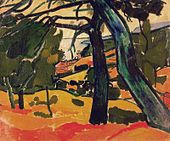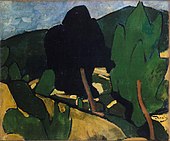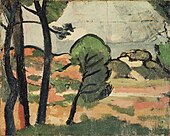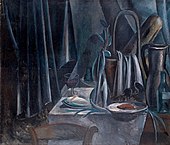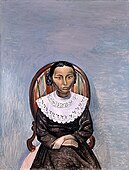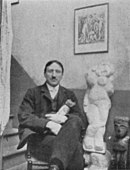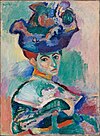André Derain
André Derain | |
|---|---|
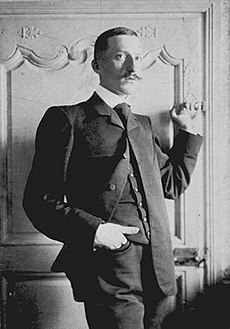 Derain in 1903 | |
| Born | 10 June 1880 |
| Died | 8 September 1954 (aged 74) Garches, Hauts-de-Seine, Île-de-France, France |
| Education | Académie Camillo, Académie Julian |
| Known for | Painting, sculpture |
| Movement | Fauvism |
André Derain (/dəˈræ̃/, French: [ɑ̃dʁe dəʁɛ̃]; 10 June 1880 – 8 September 1954) was a French artist, painter, sculptor and co-founder of Fauvism with Henri Matisse.[1]
Life and career
Early years
Derain was born in 1880 in
Fauvism
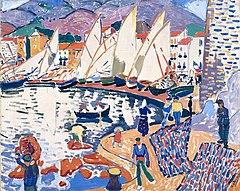
Derain and Matisse worked together through the summer of 1905 in the


In 1907 art dealer Daniel-Henry Kahnweiler purchased Derain's entire studio, granting Derain financial stability. He experimented with stone sculpture and moved to Montmartre to be near his friend Pablo Picasso and other noted artists. Fernande Olivier, Picasso's mistress at the time, described Derain[9] as:
Slim, elegant, with a lively colour and enamelled black hair. With an English chic, somewhat striking. Fancy waistcoats, ties in crude colours, red and green. Always a pipe in his mouth, phlegmatic, mocking, cold, an arguer.
At Montmartre, Derain began to shift from the brilliant Fauvist palette to more muted tones, showing the influence of
Towards a new classicism
At about this time Derain's work began overtly reflecting his study of the
After the war, Derain won new acclaim as a leader of the renewed
The 1920s marked the height of his success, as he was awarded the Carnegie Prize in 1928 for his Still-life with Dead Game and began to exhibit extensively abroad—in London, Berlin, Frankfurt, Düsseldorf, New York City and Cincinnati, Ohio.[9]
During the German occupation of France in
A year before his death, he contracted an eye infection from which he never fully recovered. He died in
Derain's London paintings were the subject of a major exhibition at the
Gallery
-
Self-portrait in studio, c. 1903, oil on canvas, 42.2 × 34.6 cm, National Gallery of Australia
-
Pinède à Cassis (Landscape), 1907, oil on canvas, 54 × 65 cm, Musée Cantini, Marseille
-
Paysage à Cassis, 1907, oil on canvas, 54 × 64 cm, Musée d'art moderne de Troyes
-
Landscape in Provence (Paysage de Provence), c. 1908, oil on canvas, 32.2 × 40.6 cm, Brooklyn Museum, Brooklyn
-
Baigneuses (Esquisse), c. 1908, oil on canvas, 38 × 46 cm,Musée d'Art Moderne de la Ville de Paris
-
View of Cagnes, 1910, oil on canvas, Museum Folkwang, Essen, Germany
-
La Table (The Table), 1911, oil on canvas, 96.5 × 131.1 cm, Metropolitan Museum of Art, New York
-
The Last Supper, 1911, oil on canvas, 227.3 × 288.3 cm, Art Institute of Chicago
-
Window on the Park (La Fenêtre sur le parc), 1912, oil on canvas, 130.8 × 89.5 cm, Museum of Modern Art
-
Nature morte (Still Life), 1912, oil on canvas, 100.5 × 118 cm, The State Hermitage Museum, Saint Petersburg, Russia. Reproduced in Du "Cubisme", 1912
-
Le Samedi, 1913–14, oil on canvas, 181 × 228 cm, Pushkin Museum, Moscow
-
Portrait of a Girl in Black, 1913, Hermitage Museum
-
Portrait of a Man with a Newspaper, 1911–1914, Hermitage Museum
-
Nu debout, 1907 (Automne), limestone, 95 x 33 x 17 cm, Musée National d'Art Moderne
-
Photograph of Derain published in Gelett Burgess, "The Wild Men of Paris", Architectural Record, May 1910. Sculpture: Nu debout (Standing Woman), 1907
Public collections
Among the public collections holding works by André Derain are:
Nazi-looted art
In 2020, a French court ordered that three paintings by Derain, Paysage à Cassis (ou Vue de Cassis), La Chapelle-sous-Crécy were restituted [19] and Pinède, Cassis should be restituted to the heirs of René Gimpel, from whom they had been looted during the Nazi occupation of France.[20] Gimpel's family had submitted the claim in 2013.[21] In 2023 Derain's Still Life With a Bottle was restituted to the heirs of Dane Reichsmann, who was murdered in Auschwitz with his wife.[22][23]
See also
References
- ^ Sabine, Rewald. "Fauvism". from Timeline of Art History. New York: The Metropolitan Museum of Art, 2000–. Archived from the original on 14 December 2007. Retrieved 2007-12-17.
- ^ Diehl 1977, p.8
- ^ Cowling and Mundy 1990, p.92
- ^ Diehl 1977 p.14
- ^ "International Painting and Sculpture - Le Cavalier au cheval blanc". National Gallery of Australia. Retrieved 2007-12-17.
- ^ "Mountains at Collioure by André Derain at National Gallery of Art". Rolfes. Retrieved 1 July 2012.
- ^ "Gil Blas / dir. A. Dumont". Gallica. 1905-10-17. Retrieved 2020-06-27.
- ^ Tom Rosenthal, reviewing Derain's London paintings on show at the Courtauld Gallery, The Independent 4 December 2005
- ^ a b Clement 1994, p. 396
- ^ a b "Works on View: André Derain". Guggenheim Hermitage Museum. Archived from the original on 25 January 2008. Retrieved 2007-12-18.
- ISBN 9780679641957.
- ^ Hamilton 1993, p. 207
- ^ Sotriffer 1972, p. 59
- ^ Cowling and Mundy 1990, pp. 92–93
- ^ "Australia Dancing leaps into Trove". Archived from the original on 2011-08-08.
{{cite web}}: CS1 maint: unfit URL (link) - ISBN 978-0-89236-891-4. Retrieved 14 February 2012.
- ^ "André Derain Biography". Namen der Kunst. Art Directory GmbH. Retrieved 2008-01-03.
- ISBN 9781588393494.
- ^ "Décision de restituer trois tableaux d'André Derain à la famille de René Gimpel". www.culture.gouv.fr (in French). Retrieved 2023-11-10.
- ^ "Marseille : un tableau du peintre fauviste Derain, butin des nazis, restitué à ses propriétaires". France 3 Provence-Alpes-Côte d'Azur (in French). 2021-01-28. Retrieved 2023-11-10.
- ^ Laborie, Aurore. "One family's battle to be reunited with art looted by the Nazis". lootedart.com. Retrieved 2023-11-10.
- ^ "In apparent first, Croatia restores looted art to grandson of Holocaust victim". www.lootedart.com. Retrieved 2023-11-10.
- ^ "La Croatie restitue plusieurs œuvres d'art spoliées au petit-fils d'une victime de la Shoah | Gazette Drouot". gazette-drouot.com (in French). 2023-09-28. Retrieved 2023-11-10.
Further reading
- Clement, Russell (1994). Les Fauves: A Sourcebook. Greenwood Press. ISBN 0-313-28333-8.
- Cowling, Elizabeth; Mundy, Jennifer (1990). On Classic Ground: Picasso, Léger, de Chirico and the New Classicism 1910–1930. London: Tate Gallery. ISBN 1-85437-043-X
- Diehl, Gaston (1977). Derain. Crown Publishers, Inc. ISBN 0517037203.
- Hamilton, George Heard (1993). Painting and Sculpture in Europe, 1880–1940. Yale University Press. ISBN 0300056494.
- Sotriffer, Kristian (1972). Expressionism and Fauvism. McGraw-Hill. OCLC 1149407.
External links
- André Derain at the National Gallery of Art
- Works by or about André Derain at Internet Archive
- Works by André Derain (public domain in Canada)
- André Derain exhibition catalogs
- Gelett Burgess, "The Wild Men of Paris, Matisse, Picasso and Les Fauves", 1910, Architectural Record
- André Derain, Museums and Public Art Galleries Worldwide, Artcyclopedia
- André Derain in American public collections, on the French Sculpture Census website


